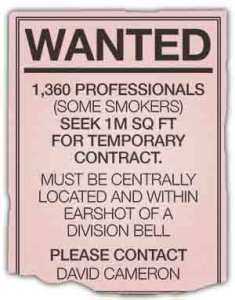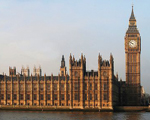 The desperate need to refurbish the Palace of Westminster means Grosvenor, Canary Wharf Group and Land Securities could be courted to offer a temporary home to MPs and peers.
The desperate need to refurbish the Palace of Westminster means Grosvenor, Canary Wharf Group and Land Securities could be courted to offer a temporary home to MPs and peers.
Three options are on the table: a rolling renovation in which work is undertaken while staff remain in the building, which would cost £5.7bn and take 32 years; a partial decant in which the House of Commons and House of Lords vacate at separate times, which would cost £3.9bn and take 11 years; and a full decant, in which the Palace of Westminster is completely emptied while work goes on, which would cost £3.5bn and take six years.
If one of the latter two options is chosen, the question the property industry will be asking is: “Where will all the people go?”
A Deloitte report into renovation options states that the space will have to “accommodate most if not all of the decanted functions of parliament [and be located] within eight minutes of the respective chambers”. This is because MPs must be able to reach their division lobbies within eight minutes of the division bell ringing to vote.
To make matters more complicated, space that will become available in 2020, which is the earliest point work can begin, will need to be identified now.
Alex Bell, real estate partner at Deloitte, who commissioned the report, said: “No sites have been identified yet and there are some very unenviable decisions to make.”
Certainly, supplying the 1m sq ft that a full decant would require will be a large task, owing to the relatively short six-year lease lengths required by the government.
David Earle, head of central London office agency at Lambert Smith Hampton, said: “Most of the landlords in this area either with space in buildings or in the process of delivering space aren’t going to want to sign a short lease.”
One building that won’t present this issue is the QE2 Centre, SW1, as it is government owned.
Craig Satchwell, director of London offices at Colliers International, said: “This problem isn’t unsolvable but the QE2 Centre is key to all of this.”
It is an obvious option for a temporary Commons chamber as it sits directly across from the Houses of Parliament and was built specifically as a secure
conference centre for the government in 1986.
The building is 350,000 sq ft and can house 3,000 delegates, but would mean 650,000 sq ft of the government’s requirement would remain unsatisfied.
So where else could potentially provide a new home?
Canary Wharf Group’s and Qatari Diar’s Shell Centre redevelopment, SE1, has the potential to accommodate the bulk of the requirement. It is set to deliver 530,000 sq ft of office space in 2019-20. Derwent London is also aiming to deliver 60,000 sq ft of space at 11 Francis Street, SW1 post 2020 and the refurbishment of Grosvenor’s 90,000 sq ft building at 52 Grosvenor Gardens, SW1, is due for completion around 2020.
Earle identifies this space as a more feasible location. He said: “Grosvenor takes a long-term view of its investments and so may be willing to accept a short- term lease at premium rents.”
Great Victoria Partnership’s 200,000 sq ft office on 40-48 Broadway, SW1, as well as Land Securities’ Zig Zag and Nova schemes, both SW1, are all possible sites for relocation.
But, as Earle says: “Most of these buildings are due to complete around 2016-17 and the landlords are very unlikely to wait around to fill their new offices.”
Blackstone’s refurbishment of the 227,000 sq ft Sanctuary Buildings on Great Smith Street, SW1, is an exception to this because it is already occupied by the government; agencies occupying the space could be relocated to accommodate the new MPs and peers.
Similarly, Tishman Speyer is redeveloping the 253,000 sq ft Eland House, SW1, which could also accommodate some of the Palace’s occupants. The building on Bressenden Place is let to the Department for Communities and Local Government until 2021 with the option of a break in 2016, which would make the move smoother.
The issue of decanting the Palace of Westminster would be made considerably easier were it not for the stipulation that staff remain within eight minutes’ walking distance of the division bell.
Earle said: “Canary Wharf would seem like an ideal location, especially considering HSBC’s planned move [of its retail bank] from the area. They wouldn’t be able to get to the Palace in eight minutes but technology has changed a lot since the division bell.”
Taking a similarly wider viewpoint, Satchwell said: “If the government were to look out further, the Olympic Media Village in Hackney seems perfect. Even though it would be occupied for only six years, it could prompt the government to create a permanent hub out there.”
Ultimately, although the decisions the government has to make are difficult, the resulting move could be a boon for the office market in the area. Earle said: “The move will introduce supply constraints to the micro market. But as it is only for the short term, it should provide a bit of churn, which will be beneficial.”











